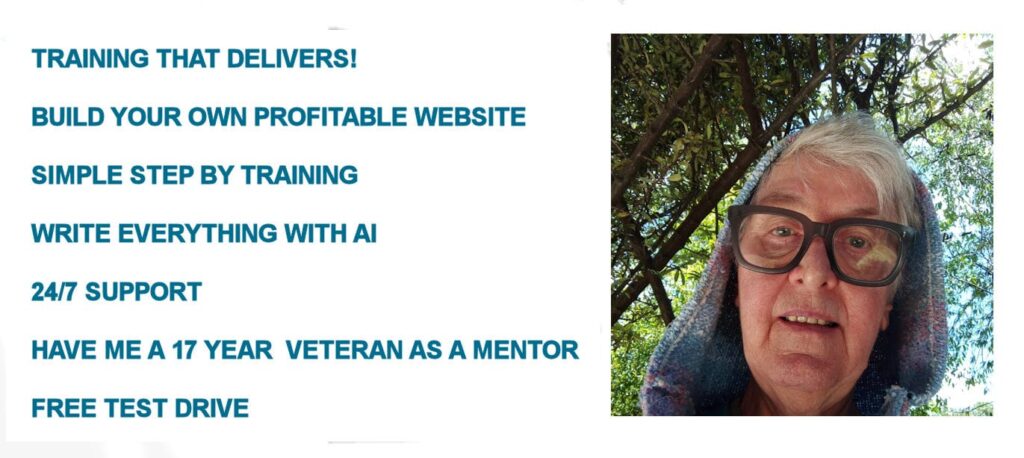Nine Secrets to Choosing Profitable Affiliate Products
There are many different types of online business models, but affiliate marketing is one of the simplest and cheapest ways to start. However, it’s crucial to understand that simple and easy are not at all the same thing. There is no magic bullet to affiliate marketing; there is no setting it and forgetting it one click solution. Yes, there are hundreds of sales pages that offer just that, but it is a pipe dream. To make this work, you need excellent training which is up to date and hard graft. But, and this is the kicker for me, affiliate marketing has fewer moving parts than almost any other online business. The key to success lies in choosing profitable affiliate products. Just because a product has a great sales page does not mean it is a great product. Understanding this is a crucial part of the affiliate marketing journey.
Table of contents
- Some Housekeeping
- The Best Internet Marketing Training.
- Know Your Audience.
- The Five Crucial Points to Bring it All Together.
- 1. Choose Products that Solve Real World Problems.
- 2. Match Products to Your Audience’s Needs
- 3.Pick Products That Are Hot and In Demand
- 4. Sales Funnels Mean More Cash
- 5. Balance Low-Ticket and High-Ticket Items for Profit.
- 6. Partner with Well-Respected Vendors
- 7. Rely on Reviews to Ensure Quality.
- 8. Focus on Evergreen Niches.
- 9. Negotiate a Discount With the Vendor.
- Conclusion to Nine Secrets to Choosing Profitable Affiliate Products
- Faq’s For Nine Secrets to Choosing Profitable Affiliate Profits
Some Housekeeping
There are only five points to get right as an affiliate marketer, but before we get to them, we must cover why you need to know your audience. This is non-negotiable. First, you have to choose an audience and then understand them. I didn’t make a penny from affiliate marketing for years because I tried to talk to everyone. It didn’t end well for me, and it won’t for you either. The training below put me on the right path.
The Best Internet Marketing Training.

Know Your Audience.
As an affiliate marketer, understanding your audience is crucial because it directly impacts your ability to connect with potential customers and drive conversions. The process of understanding your audience involves researching their needs, preferences, and, most of all, their pain points. This can be done through surveys, social media interactions, and analyzing your website’s analytics. When you know who your audience is, you can tailor your content, product recommendations, and marketing strategies to resonate with them on a deeper level.
This targeted approach has two advantages. First, it builds trust and credibility; people buy from people they know, like, and trust. Second, when you speak to the heart of your audience’s problem, they resonate with your content. Once they are truly engaged, they are more likely to buy through your affiliate link.
Once I truly understood this, my conversions went through the roof. Without this insight, your efforts will probably fail (sorry to be brutal). I am telling you this because I don’t want you to miss opportunities to make money. More and more sales are being made online, and everyone can do this.
The Five Crucial Points to Bring it All Together.
Get these five points right, and sales, aka commissions, will automatically follow. You know your audience. You know their pain points because you have spent hours on social media reading and listening to what questions they are asking and what problems need a solution. Now, it’s all about introducing them to products or services that not only benefit them but also give them the confidence and reassurance they need.

I hope you read the last sentence correctly. Promote products that genuinely benefit people, not products that make you the most money. I know that you want to make money; you would not be reading this if you didn’t. Promoting products that give you the most commission is a short-term and, frankly, wrong strategy. Let’s talk real money here. You can promote products with great sales pages but products that don’t deliver any credibility or value. Or, you can be authentic and accurate and promote products that genuinely help people. Remember, authenticity is not just a buzzword; it’s a guiding principle that can inspire the best affiliate marketers. However, with a bit of research, you can find profitable affiliate products that align with your goals. This applies to all profitable niches; it’s not restricted to the make-money online niche.
When I write an article like this, I imagine all my readers around the kitchen table (all five of you. I thank every one of you.) No, I imagine a big wooden table in a kitchen full of friends. We are all having a beer, and I am leaning against the kitchen door jam, listening to you all and jammin’. When I recommend something to you, I use it all the time. I have been a member of Wealthy Affiliate for 17 years since 2007. I watch at least three new training videos weekly and always learn something. So, I have no hesitancy in promoting it because it genuinely helps people build a sustainable online business. Start your free account here. As an aside, I always think of my readers as friends; if you think of them as strangers, you will not be able to address their problems. I have had the same issues as my readers over the years, so I know where they come from. I can offer the best solutions because I know all their pain points.
1. Choose Products that Solve Real World Problems.
Let’s imagine you have a splitting headache. You will reach for a painkiller rather than suffer your headache. That is because you know what to do, and you don’t have to read a long-form sales letter to achieve your ideal solution. You want to solve the problem with the least possible disruption to your life. If you have just gone through a traumatic and painful breakup, you may be looking at solutions to get your ex back. If you are still a lanky teenager you may well buy a 12 week training program that shows you how to build muscle in 12 weeks. Marketers struggling to get their pages seen by more people will investigate how to learn and use Search engine optimization.
What all of these examples have in common is the fact that people are in pain. The pain doesn’t have to be physical. Your job as a successful affiliate marketer is to show them products that ease their pain, and preferably, make them feel empowered and in control by providing easily accessible solutions.
This brings us succinctly to the next point………………
2. Match Products to Your Audience’s Needs
Promote products that resonate with your audience and are tailored specifically to their needs. For example, if your audience is interested in fitness, you could recommend high-quality protein supplements or workout gear. If someone suffers from a cold, you wouldn’t recommend a laxative to stop sneezing! Equally, if they are constipated, they don’t need tissues. At the same time, the product you recommend must provide real value. To go back to an earlier point, you don’t want to be one of those many sleazy, scuzzy affiliate marketers who promote products that under deliver.
Sure, promoting crap products will get lots of sales. I have never promoted a product just for money, so I can’t say this from personal experience, but I am sure the refund rate will be through the roof. What is the first thing you would do if you bought a shoddy product? I am certain you will try to get your money back. And I am pretty sure the second thing you would do is stop listening to the advice of the affiliate who promoted it. I have definitely done the second bit. I stop listening to affiliates who promote shoddy products. This damages your reputation and undermines your audience’s trust, which is the most valuable asset in affiliate marketing.
My Hard Line
This is a hard line for me: one strike, and you are out. I know marketers who steal other people’s products and then claim them as their own. In the Warrior Forum, people often take PLR (Private Label Rights) products, which are products that can be legally edited, modified, and published as your own, and sell the resale rights—even without a proper license to do so. Once this happens, I get off all their lists, and in effect, they go in my little black book. I never buy from them again. You may not have such a hard line, but it is up to you where you draw your line.
3.Pick Products That Are Hot and In Demand
The vast majority of wannabe affiliate marketers never get off the ground. Generally, they tend to be followers, believing in the latest and most popular trends. People often overlook older, proven methods and products, thinking newer is always better. They’re constantly chasing the next shiny object. The new shiny object may work, but people won’t spend the time trying to make it work. They want instant results and will never stay long enough to make it work.
A doctor, the eponymous Dr. Atkins, wrote itAs a senior affiliate marketer, let me give you a real-life example. The Atkins diet was all the rage back in the day and has been proven to get results—but no one mentions it these days. I can attest that as a teenager, this was my go-to diet. I lost fifty pounds with it. It was written by a doctor, the eponymous Dr. Atkins. It was strict, with lots of raw fruit and vegetables, but it worked.
Today all everyone talks about is keto diet and Dash Diet.
Stop digressing, Catherine, and get back to affiliate marketing. For years I thought that promoting these new shiny objects was a sleazy way of doing business, and I refused to do it. Nowadays, I realize I am not responsible for what people want to buy. So jump on the bandwagon and promote what the people want. Don’t try to ‘bring back’ products that have been forgotten. Justin Timberlake tried bringing sexy back and even he failed. Of course, point one and two stand. Choose Products that Solve Real World Problems and Match Products to Your Audience’s Needs
Promote what sells and make sure these are profitable affiliate products
An example of this in real terms back in the day I knew an affiliate marketer from the UK. His name was Ben Fletcher, to be fair, his name is still probably Ben Fletcher. Here is something from an old sales page I used to think promoting new shiny objects was morally wrong, it took me years to understand my mistake. Actually to be fair I think it was actually talking to this guy, that put me straight. There is no need for me, or you to make judgements on why people buy products, you just have to make sure they are profitable affiliate products, they align with your goals and they are reputable.
But here’s what I’ve come to realize…
Ben Fletcher.
Most people who buy this will do nothing with it—nothing, zilch, nada—even though the content is solid and I’ve emptied my soul into this “warts and all.”
They’ll move on to the next ‘goo-roo pump & dump “answer to their prayers” piece of crap product and guess what, they’ll do nothing with that either…so no threat to me there!
. It teaches you so many methods to be a super affiliate. This is a link to one of Ben’s products that is still under $10. It is over three years old, but still as relevant today. It teaches you so many methods to be a super affiliate; he has more modern products, but this is still solid and relevant. Don’t get me wrong, all his products are relevant and all worth buying. Ben Fletcher I know this old product still works because I successfully use the methods today.
4. Sales Funnels Mean More Cash
If you’re an Amazon Associate, you know that Amazon is a selling machine. The guy who clicks on your Amazon affiliate link for a magnesium supplement might end up buying a pool table for his house. The entire Amazon site is a sales funnel. They always show you related products and tell you, “People who bought this also bought this?”
Oh really? Did they?
No one knows. But what we all know is that Amazon makes billions in sales.
As an affiliate marketer, you play a crucial role in this process. Similarly, if you’re promoting products from other vendors on platforms such as ClickBank, e-commerce stores, software sites, etc., you’ll want to check if they have a sales funnel with upsells and downsells. Your role is integral to the success of the sales funnel strategy.
When you promote products with a sales funnel, you’re not just selling a single item. You’re opening the door to a cascade of potential sales. If related and useful upgrades are in the funnel, a significant percentage of your leads will also buy these products. This means your commissions will increase considerably. So, it’s best to promote products with a sales funnel to maximize commission. This strategy is effective and can significantly increase your commissions.
What is A Sales Funnel?
A sales funnel is a strategic process that guides potential customers through a series of steps designed to lead them from initial awareness of a product or service to the final purchase. The funnel is USUALLY divided into stages: the top of the funnel (TOFU), where leads are generated, and awareness is built; the middle of the funnel (MOFU), where leads are nurtured through targeted content and engagement; and the bottom of the funnel (BOFU), where prospects are converted into paying customers.
Each stage of the funnel requires different strategies, such as content marketing, email campaigns, or personalized offers, to move prospects closer to making a purchase. However, it’s important to always keep the ultimate goal in mind: increasing conversion rates. By systematically addressing the needs and concerns of the target audience at each stage of their buying journey, you can stay focused and goal-oriented in your sales funnel strategy.
How Can you As an Affiliate evaluate a sales funnel
One way I do that is to promote products from people I know who ALWAYS make sterling products. Yes, they have fantastic sales pages. Here is one from one of my favorite Internet marketers, Kevin Fahey. He has a very heavy Cork Accent (Irish), but he knows his stuff. He is also an excellent PLR Seller; here is one of his best products for Email marketing. I have adapted that content to sound like me on this blog.
This targeted approach has two advantages. First, it builds trust and credibility, and people buy from people they know, like, and trust. Second, when you speak to the heart of your audience’s problem, they resonate with your content. Once they are truly engaged, they are more likely to buy through your affiliate link.
Once I truly understood this, my conversions went through the roof. Without this insight, your efforts will probably fail, (sorry to be brutal). I am telling you this because I don’t want you to miss opportunities to make money. More and more sales are being made online and everyone can do this.
Conversion rate
Start by evaluating the funnel’s conversion rate, which is the percentage of leads that make a purchase after entering the funnel. A high conversion rate at each stage—from initial engagement to final sale—indicates a well-optimized funnel. As an affiliate, this tells you that the funnel is successful in converting interest into revenue, which is crucial for maximizing your commissions.
Start by gaining access to the analytics or performance dashboard of the sales funnel you’re promoting. This data might be provided by the product owner or available through affiliate platforms like ClickBank, ShareASale, or others.
Lead Quality
Pay attention to the quality of the leads that the funnel attracts. High-quality leads are those who are highly aligned with the product’s target audience and have a higher likelihood of converting. If the leads are engaging with the funnel’s content and progressing through it smoothly, it’s a good sign that the funnel is effective and worth promoting.
If you have access to demographic and behavioral data from the funnel, analyze who the leads are in terms of age, gender, location, interests, and online behavior. Look in Google Analytics, Facebook Insights, or the affiliate program’s reporting dashboard. High-quality leads should match the ideal customer profile for the product you’re promoting.
Engagement Metrics
Look at how leads interact with the content at each stage of the funnel. High engagement—measured by metrics like click-through rates, time spent on pages, and email open rates—suggests that the funnel resonates well with its audience. As an affiliate, this is important because it indicates that the funnel is compelling and can keep potential customers interested, increasing the chances of conversion.
Customer Feedback
Consider the feedback from customers who have gone through the funnel. Positive reviews, low drop-off rates, and repeat purchases indicate a strong and trustworthy funnel. This feedback can be particularly useful in determining whether the funnel delivers on its promises, which is essential for maintaining your credibility as an affiliate.
Return on Investment (ROI)
Calculate the ROI of the funnel. A funnel that generates more revenue than the cost of driving traffic to it is a good candidate for promotion. As an affiliate, your goal is to ensure that your promotional efforts are profitable, so a funnel with a high ROI is a strong indicator that it’s worth your time and effort.
Funnel Adaptability
Lastly, consider the adaptability of the funnel. A good funnel should be flexible enough to adjust to changes in the market, product offerings, or audience behavior. If a funnel can be easily optimized or updated based on feedback or new trends, it’s likely to remain effective over time, making it a reliable choice for ongoing promotion as an affiliate.
5. Balance Low-Ticket and High-Ticket Items for Profit.
In the ‘make money online’ scene, there’s often a lot of talk about only promoting high-ticket products because the amount of effort required to promote these products is the same. TO BE FAIR THAT IS ABSOLUTELY TRUE.
Of course, there is a caveat. You often need to be told that most people can’t or won’t pay for costlier items. By neglecting the hordes with lower purchasing power, you’re leaving money on the table. However, by catering to both high-ticket and low-ticket buyers, you’re opening up new sales opportunities and potentially increasing your revenue.
The Past Is Not Now
I have recommended promoting high-ticket offers in the past, but the world is changing. We live in uncertain times, and many people think there will be another economic crash. Now, in 2024, I strongly suggest mixing low- and high-ticket products. This approach gives you the flexibility to adapt to changing market conditions and cater to a wider range of buyers, putting you in control of your marketing strategies.
For example, if you’re promoting a page-building tool to online marketers, you may promote Systeme.io, which has a $27 monthly plan. This will appeal to most newbies who are on a tight budget. By clicking the link, you can start your free account and see what I am talking about.
But you can mention that while Systeme.io’s page builder is decent, it comes nowhere close to OptimizePress’s awesome page builder, which creates pages that make people sit up and notice.
Currently, OptimizePress costs $199/year for one site. Their affiliate program pays 30% of every front-end sale, which is $82.80.
Pay Attention to what I am recommending here………
Your audience, who reads your recommendations, will now have a choice.
They can either go for a cheaper but still reliable Systeme.io – or they can go with the fantastic OptimizePress, which will create high-converting and aesthetically pleasing sales pages.
You are effectively targeting both types of buyers. Those who prefer spending less… and those who wish to spend more to get more. By doing so, you’re not only meeting the needs of a diverse audience but also potentially increasing your sales and revenue. One way or another, you’re making sales and getting paid, and the possibilities are exciting.
6. Partner with Well-Respected Vendors
When promoting products online, some products will be sterling, they offer great value. While others are so atrocious you would want to ask for a refund and send them back even if they were free.
In the ‘make money online’ niche, it’s crucial to always promote products from reputable vendors. Your reputation is directly tied to theirs, and by promoting their products, you’re not just selling, you’re endorsing a quality that your audience can trust.
If they’re selling rubbish products and you promote them unquestioningly, your customers will be upset, and you’ll get tarred with the same brush, meaning your reputation will suffer as well.
As an affiliate, building trust and credibility with your audience is crucial . Without that trust they will not follow up and buy. Always prioritize your audience’s needs over immediate profits. This may seem counterintuitive, but I assure you, in the long run, it is the most sustainable and rewarding strategy.

Promote solid, proven products that are delivered – from reputable vendors who provide good customer support. Once you have the reputation of someone promoting dodgy products, it does not matter how often you reinvent your image. Your past will haunt you. I have nearly three decades of successful affiliate marketing behind me, and I have seen this many times. Choosing profitable affiliate products is easier with this strategy. You can run, but you can’t hide. Nothing about your reputation goes away once it is out there. So protect your reputation at all costs.
7. Rely on Reviews to Ensure Quality.
Prior to endorsing any product or service, it’s crucial to invest time in comprehensive research. Delve deeper into online resources to unearth authentic customer feedback, often hidden in the later pages of Google search results. This review research provides a more accurate understanding of the product or service you’re considering for promotion.
It’s important to note that many top-ranked reviews are from affiliates who are actively promoting the product, often with fervent praise. While these reviews may appear reliable, it’s crucial to remember that affiliates are driven by sales. Therefore, it’s wise to read between the lines, maintain a healthy dose of skepticism, and not let these high-ranking, glowing reviews be the sole influence on your decision. Keep in mind that every affiliate, including myself, is driven by a sales agenda.
My advice is to be diligent and not to take page 1 or 2 reviews as the ultimate truth. Instead, dig deeper and seek out verified customer reviews. This principle holds true whether you’re on Amazon or any other platform. Your diligent research will yield significant benefits in the long run.
“We see our customers as invited guests to a party, and we are the hosts. It’s our job every day to make every important aspect of the customer experience a little bit better.”
jEFF Bezos
On Amazon, it’s easy to check a product’s stats. You can see the number of units sold and the star rating, which ideally should be around 4-5 stars… and there will be many customer reviews that you can go over.
With thorough research, you’ll determine whether a product is high-quality and Promote it if it meets your criteria.
8. Focus on Evergreen Niches.
An evergreen niche does not have substantial seasonal changes. For instance, promoting Halloween costumes is a very niche area. It is profitable but only for about six weeks a year. Some examples of evergreen niches are weight loss, survival (prepper), making money online, reducing stress, holistic health, mindset, positive thinking, etc.
Focusing on an evergreen niche will ensure that you’ll always have an audience to market to. Be aware that over time, you will blog hundreds of articles. I use affilininja, a WP plugin. that allows you to change your links with one click if they change for any reason.
9. Negotiate a Discount With the Vendor.
I love using this strategy because few affiliate marketers use it. I’m not sure why; maybe they can’t be bothered to network and establish a relationship with a vendor. When you build a good relationship with a vendor, you’re both invested in each other’s success. As you drive more sales, the vendor benefits from increased revenue, and you benefit from higher commissions. This symbiotic relationship encourages both parties to work together towards a common goal: creating profitable affiliate products.
Vendors are more likely to provide affiliates they trust with exclusive deals, discounts, or early access to new products. These special offers, available only to a select few, can attract more customers and increase conversions, which in turn benefits both you and the vendor.
Real Life Example
For example, if a new make-money course sells for $97 a month, but you can get it for just $47 for a week or so, the special discount has the potential to significantly boost your sales if you promote it to your list or on your blog. People love getting a discount, which is one reason the AppSumo site is so popular. The special deals are a big draw.
Of course, you’ll need to network and ask the vendors if they’ll offer you a discount coupon or a special for your audience.
If you have a sizeable audience, most of the time, you’ll get a “Yes!” because it’s a win-win-win for all three parties involved—the vendor, the customer, and you! However, don’t try it if you are just starting out because, without an online presence and traffic, there is no incentive for the vendor.
Finally…
Affiliate marketing is all about connecting with your audience and offering real value. Remember, your audience is your most valuable asset, and providing them with genuine value is the key to your success.
Focusing on what genuinely matters to your readers and staying ahead of trends will build trust and make you stand out.
Nail these nine secrets, and your affiliate income will grow like never before.
Conclusion to Nine Secrets to Choosing Profitable Affiliate Products
Be very clear what your objectives are when choosing a product to promote. Be aware that every product you promote has the ability to make or break your reputation as an affiliate. Once your reputation is broken online it’s tough to repair it.By choosing profitable affiliate products is about more than just picking popular items. It requires a strategic approach that balances market demand, product quality, and personal alignment with the brand. By focusing on these nine secrets—from understanding your audience to building strong vendor relationships—you can maximize your chances of success in affiliate marketing. Remember, the key is to offer value to your audience while also ensuring that the products you promote are both trustworthy and lucrative. With careful selection and consistent effort, you can build a profitable affiliate marketing portfolio that benefits both you and your audience..







One key secret you discussed here is to “Choose Products that Solve Real World Problems.” By aligning affiliate products with tangible needs, marketers connect authentically with their audience, increasing trust and conversions. Addressing actual problems (like pain relief or SEO needs) allows affiliates to market solutions rather than gimmicks, fostering long-term engagement.
For a newbie If I’m just starting out, how can I tell if a product truly solves a real problem or if it’s just marketed well? Any tips for identifying genuine solutions over flashy trends?
Certainly, I’d be glad to help clarify this! As you’re getting started, learning to distinguish genuine problem-solving products from trendy ones can seem tricky at first, but there are some clear ways to evaluate products effectively.
One of the most effective methods is to **research user reviews and feedback** outside of the company’s marketing materials. Check platforms like Reddit, Quora, or Trustpilot, where people often share their real experiences, unfiltered. This way, you’ll get a sense of how the product actually works for everyday users.
Additionally, ask yourself whether this product offers a measurable benefit or addresses an essential pain point. A “real problem-solving product” usually provides a solution to a specific, relatable issue. For example, think of products that improve health, streamline business processes, or save people time—these are usually solving tangible issues.
Another tip is to **follow industry trends and professional opinions**. Look for insights from trusted bloggers, industry influencers, and experts who review these products in-depth. These reviewers often bring an experienced eye and will break down which products are “hyped” and which actually make a difference.
Finally, as you build experience, you’ll get better at identifying the tone of authentic marketing vs. hype. Genuine problem-solving products focus on the practical, like how they save time or money, while gimmicky products may use more flashy, emotion-driven appeals without much detail on functionality.
It can take some practice, but over time, you’ll find your intuition gets sharper! Let me know if you’d like specific examples or further guidance on any part of this process—I’m here to help!
Thank you, being new to Affiliate Marketing, and online Marketing has brought me into a whole new arena of growth and ideas.
I am a new member of WA. I am learning so much here at WA and reading these posts, doing the training, and even reaching outside of the WA program. You have listed here, very well I might add, the best ideas for getting profit from affiliate marketing,they are obviously written by someone with long experience.
In my view the most crucial aspect of making money is knowing your audience and their pain points
It’s wonderful to hear about your enthusiasm for affiliate marketing and the growth you’re experiencing as a new member of WA! It’s clear you’re diving in wholeheartedly, not only by engaging with the training but also by exploring resources outside the program, which is a fantastic approach. Broadening your perspective and applying insights from various sources will definitely give you an edge as you develop your skills.
You’re absolutely right that knowing your audience and their pain points is the foundation of success in affiliate marketing. When you understand what your audience truly needs or struggles with, you can position your products or services as the ideal solution. It’s not just about promoting something but about building trust and showing your audience that you genuinely want to help them achieve their goals or overcome challenges.
The way you’ve recognized and appreciated the quality of the ideas shared here speaks volumes about your dedication to learning. Keep that curiosity alive—it’s a key trait of successful marketers. With your focus and willingness to learn, I have no doubt you’ll continue to grow and see great results. If you ever want to bounce around ideas or need guidance, I’m here to help!
I really liked your emphasis on choosing products that align with an audience’s actual needs and solve real problems rather than just chasing high commissions. Connecting genuinely with the audience builds trust and long-term success, something many overlook in favor of quick gains. I found this out the hard way when I first started Internet marketing; I was only interested in profit. The part about building strong vendor relationships and negotiating discounts is great advice! As I learned more about understanding the problems in my niche and how to address my content with these problems in mind, I found products worth promoting. It is a strategy that pays off in the long term. Thanks for this detailed, step-by-step guide. It’s clear, practical, and grounded in solid principles!
Yes, I hear you very often. Newbies just don’t get the connection between your relationship with your readers. Without that connection they don’t feel that you get them and they are not going to follow up with any of your calls to action
You did an awesome job explaining how to evaluate potential products by looking at factors like commission rates, market demand, and product quality. Your tips on balancing personal interest with profitability were really insightful—it’s such a crucial balance that many overlook.I’m curious, do you have any favorite tools or resources that help streamline the process of researching affiliate products? And, have you found any niches that tend to consistently perform well for beginners? Thanks for sharing such practical tips—this is going to help a lot of people get a solid start in affiliate marketing!
Thank you so much! I’m glad the tips resonated with you. When it comes to researching affiliate products, there are definitely some tools that can make the process more efficient. For finding high-quality products with solid commission rates, **Affiliate networks** like **ShareASale**, **CJ Affiliate**, and **Rakuten Marketing** are great starting points, as they offer access to a wide range of products across different niches. **ClickBank** and **Amazon Associates** are also user-friendly, especially for beginners who want variety.
For market demand research, **Google Trends** is a straightforward, free option to help gauge interest in a product or niche over time, and **Ahrefs** or **SEMrush** can offer deeper insights into keyword trends and competition if you’re ready for a more advanced tool. **BuzzSumo** is another valuable tool for spotting trending content and topics, which can be especially helpful if you’re trying to match affiliate products to popular subjects.
As for niches that tend to perform well for beginners, **health and wellness**, **personal finance**, and **DIY/home improvement** are often reliable choices because they cover evergreen interests with large audiences. **Pet care** and **sustainable living** are also growing niches with lower competition, where beginners can make a strong start. Balancing personal interest with profitability is key here—having enthusiasm for your niche often makes your content more genuine and engaging, which translates into better conversions.
Thanks again for your feedback, and best of luck in your affiliate marketing journey!
Hello Catherine,
I appreciate your time and effort in putting together this informative piece “nine secrets to choosing profitable affiliate programs”
As you correctly pointed out in your engaging piece, affiliate marketing is one of the simplest and cheapest ways to start an online business. However, I doubt one can be successful in this without adapting and taking a cue from the points enumerated and explained in this article. They are, in my opinion, the bedrock of success in affiliate marketing.
What strikes me most is the section on choosing products that solve real-world problems. I agree with this and found it to be true. I remember the last vacuum cleaner I had didn’t perform as expected or as marketed by the salesman.
This caused me anxiety and broke my heart. Not until I read a review of a robotic vacuum cleaner somewhere about its capacity, ruggedness, durability, and ease of use. Based on the review, I purchased it online. Since then, I’ve been enjoying it, and it has not given me any issues! The review pointed me in the right direction, and more importantly, the problem was solved.
However, in your next article, could you suggest ways to encourage customer feedback in affiliate marketing without being too pushy?
Thanks for sharing this educative article.
Regards,
– Makinde
Dear Makinde,
Thank you for your thoughtful feedback and comment on my article entitled “Nine Secrets to Choosing Profitable Affiliate Programs.” I’m delighted to hear that the section on selecting products that address real-world problems resonated with you. Your experience with the robotic vacuum cleaner underscores the importance of promoting solutions that genuinely meet consumer needs.
Regarding your question on encouraging customer feedback in affiliate marketing without being overly assertive, here are some strategies that can bring about positive changes:
Create Engaging Content: This is the primary recommendation to develop content that invites interaction, such as blog posts that ask for readers’ opinions on a specific topic or videos that encourage viewers to share their experiences with a particular product or service.
Utilize Social Media: I recommend you leverage platforms like Facebook, Instagram, or Twitter to foster discussions and gather feedback in a more casual setting. To do this really effectivley master one platform before going on to others.
Implement Surveys and Polls: Use brief, user-friendly surveys or polls that respect the audience’s time and make it easy for them to share their opinions.Offer Incentives: Provide small rewards, such as discounts or access to exclusive content, to motivate users to share their thoughts.
Respond to Feedback: Show appreciation for feedback by acknowledging it and, when appropriate, implementing suggestions. This demonstrates that you value your audience’s input. More importantly your reader can see your responses.
By integrating these approaches, you can gather valuable insights while maintaining a respectful and engaging relationship with your audience.
Warm regards,
Catherine